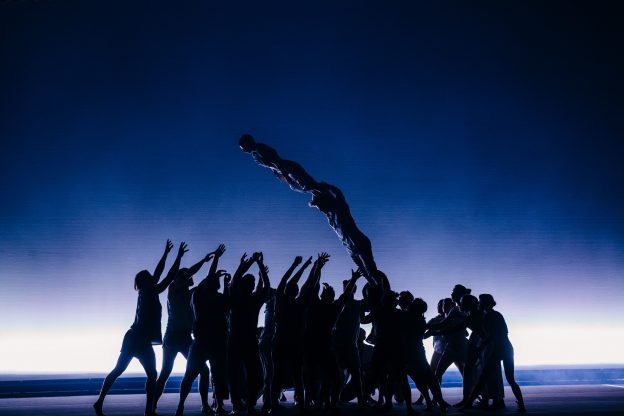Small gods, humans, animals and a brave space. Dorothy Max Prior samples some of the many circus shows on offer at the Edinburgh Festivals 2022
Over the past decade, circus has become an increasingly important part of the Edinburgh Fringe, with key venues such as Underbelly and Assembly making space for some of the world’s top companies. I’d like to think that the attention given to circus by the Total Theatre Awards might also have helped to push things forward!
In 2015, the ante was upped with the creation of Underbelly’s Circus Hub on the Meadows – the first major Ed Fringe venue dedicated exclusively to circus and cabaret. Circus Hub is made up of the Lafayette (a 550-seat big top) and The Beauty (a 500-seat spiegeltent). In case you’re wondering, the spaces are named after one of the world’s most famous circus performers and illusionists – The Great Lafayette and his dog Beauty, who both died in Edinburgh in 1911. It goes without saying (but I’ll say it anyway) that the advantage of having circus-dedicated spaces is that there are, one would hope, fewer issues with rigging and get-ins. Having previously produced shows incorporating aerial at the Fringe, I can personally testify that dealing with venues not usually set up for circus work is an absolute pain. Circus Hub sensibly alternate shows between their two venues, allowing for a decent amount of time (by Ed Fringe standards, anyway – sometimes a whole hour, for goodness sake!) for get-ins.
Of course there’s been a bit of a gap due to a certain global pandemic, but this year saw the return of the Edinburgh Fringe to its usual boisterousness, and it was a delight to see a whole host of great circus shows – at Circus Hub and other venues – ranging from the family-friendly feel-good shows through to the experimental edge where circus meets live art. Something for everyone, then.
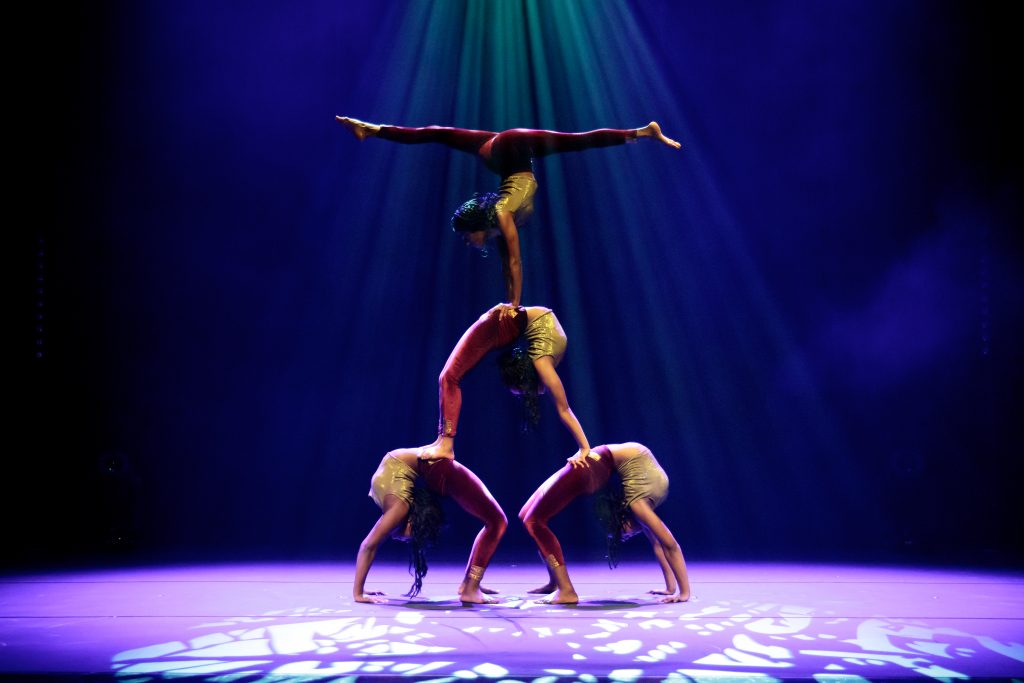
At the feel-good end of the spectrum, Circus Abyssinia are always a pretty safe bet for a fun-for-all-the-family outing. Here, they present their most recent show Tulu, which is inspired by Ethiopian athlete and icon, the long-distance runner Derartu Tulu. The show starts with a run around the space and the voice of a sports commentator celebrating her achievement (she was the first Ethiopian woman and the first African woman to win an Olympic gold medal). The theme is picked up on now and again as the show progresses – we get a nice image of the Olympic five-ring emblem that prefaces a great hoop-tumbling act, a bit of flag-waiving and parading, and the lead five acrobats’ costumes reference the Ethiopian kit. Oh, and a fire juggling scene that starts with a flaming torch run and handover/lighting moment. But not everything can be forced to fit the theme, so we also have some lovely contortion by two young women dressed as cheetahs (OK, fastest land animals so maybe on-theme after all!); an old-school, but good with it, rollerskating double; some great all-female acrobalance/hand-to-hand; an extraordinarily good male hand-balancer, who later does a gorgeously controlled straps act, featuring a perfect box-split held totally still for what seems like an impossible amount of time; and a fabulous Russian Swing finale that brings the house down. All delivered to a great Ethiopian/African soundtrack that moves from folkloric to rock to jazz, and often a magical blend of all three modes.
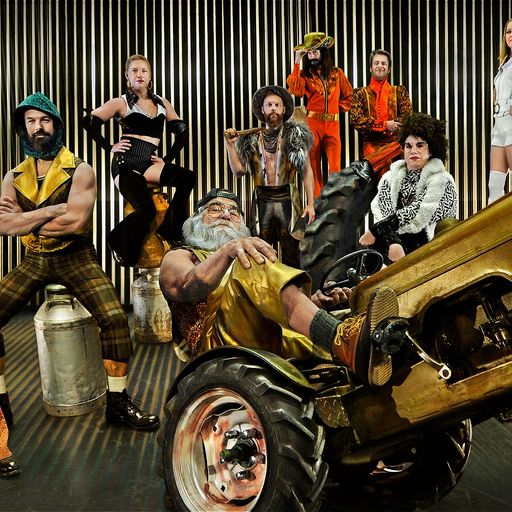
Also in feel-good mode, but with a little more edginess, comes Cirque Alfonse with Animal. So we’re talking farm animals here, not circus animals. And this is not a sentimental trip to the petting farm, it’s a feisty grown-up take on farm life – I saw a couple of small children getting pretty worried about the references to the abattoir, and the general loud boisterousness of it all was too much for some of the little ones. But the venue/company clearly give the age recommendation as 12+ so what can you do if people ignore the guidance? As ever, the Alfonse team of butch beardy men and athletic women give us a breathtaking display of physical skills – all aided and abetted brilliantly by the musicians with their fantastic mulch of rock and roll and Quebecois folk. And some of the acrobats sing and play, too – so there’s a constant changing roster of instrumentation as drum kit, guitar, bass, keyboards, trumpet and musical spoons all come into play. Plus, clog dancing!
So what do we get, circus-wise? Lots, and it’s all somehow weaved into the farm theme. We have object manipulation – pitchforks and buckets-of-grain and milk churns are juggled and rolled and tossed. We have hand-balancing (those milk churns put to use again). We have teeterboard (of course we do, it’s Cirque Alfonse!) incorporating big plastic pigs and chunky tyres; and we have wheelbarrow races. Then, there’s the egg balancing, and the singing and dancing plastic chickens. There’s a ridiculously silly big dancing cow, and a tossing of the giant cowbells act. And we have a phenomenal bucking bronco finale on a big bull. Weaving through all this is a great clown character, a Granddad farmer with a gristly white beard and dungarees who stomps and sings and rides his tractor through the onstage mayhem. It looks rough and ready, but is meticulously designed and executed. Good, dirty fun – a fabulously raunchy display of circus skills, physical theatre, and music from a brilliant ensemble.
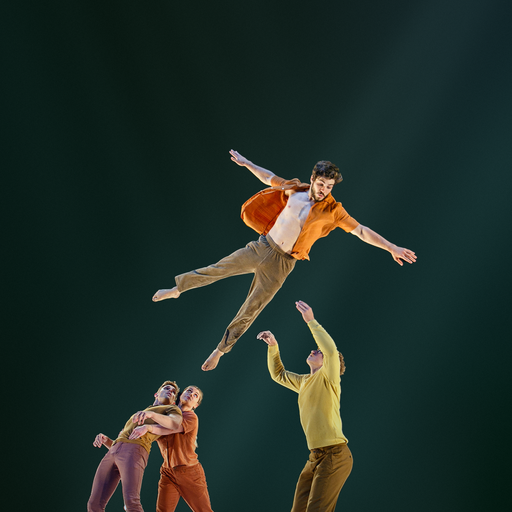
Following on from Animal is a show that couldn’t be more different, aesthetically and in the type of skills employed. Australian company Circa are back with Humans 2.0 – an evolution of the show Humans that has played twice previously at Circus Hub. But each new incarnation of the show is its own thing, exploiting the specific physicality and skills of whoever is in the ensemble at the time. The design is pure and simple, relying on a strong music score and excellent lighting to provide all that’s needed by way of the scenography. There is no set or props – just a white dancefloor making a circle. Sometimes there are lightning flashes, and sometimes the circle is lit red. There’s nothing to interfere with the fact that it’s all about the human bodies in the space – an ensemble of ten who work all together or in small groups, with the very occasional solo moment. Circa’s artistic director, Yaron Lifschitz, has said that he created Humans 2.0 to capture the challenge of being human. The show explores ideas around trust, support, balance, and collaboration: bodies are tossed to each other at phenomenal speed, three-person towers rise and fall effortlessly, women and men base other women and men as if lifting feathers – from standing, or lying, or kneeling, or (provoking gasps of astonishment from the audience) from bridge position. In a moment exploring risk in a way that the audience can identify with – much of the time, the action is so swift and perfectly executed we don’t see the risk – an acrobat leaps in the air, seemingly expecting to be caught, but instead hits the floor. Circa can afford to play these sorts of games – their level of skill and brilliantly timed execution of everything they do is so very high. A breathtakingly beautiful show I could watch a hundred times.
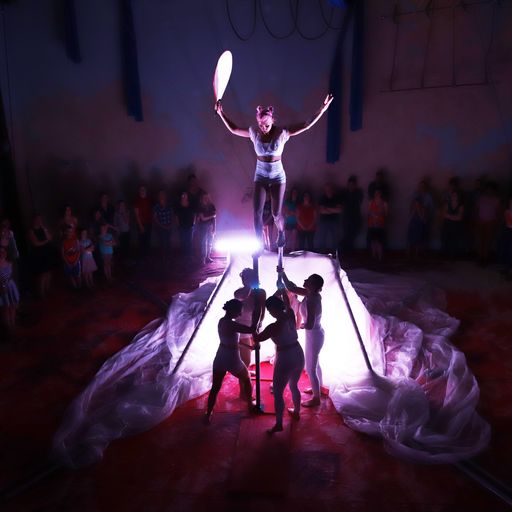
All of the above are performed in The Lafayette tent. Over in The Beauty spiegeltent, there’s a very lovely morning show that is very different to anything else on at the Hub or elsewhere in the Fringe. Brave Space is brought to us by the all-female Chicago-based Aloft Circus Arts company. Each show is for a maximum audience capacity of 100 – and this is because they create a space within the space, building a safe haven from scaff poles and white parachute silk, a constantly-evolving structure that morphs from womb to enormous hooped skirt to secret den to circus tent. The performers move along and around and under the structure, creating gorgeous shadow images from within, or outside the structure walking along horizontal metal poles, and dancing and spinning on vertical poles. The audience start out watching, but get drawn into the action. First it’s making a big circle, and a lift of the parachute silk – Girl Guide style – in a great big whoosh. Then, we are asked to put the cloth over our heads, and crawl underneath. Join in now or miss the rest of the show, our ‘ring-mistress’ calls out to those on the edge hesitating. Chairs are brought for those less able to stand or site on the floor. The tent grows around us. Now, with everyone inside, volunteers are gently brought in to the action, to hold poles or ropes or hoops. We are just inches from the performers as they twirl their hoops or juggle or climb and balance. in one extraordinary moment, we are invited to lie down under the trapeze to watch the aerial action with a worm’s eye view. Health and safety be damned! A warm and wonderful show, bringing some real beauty to The Beauty.
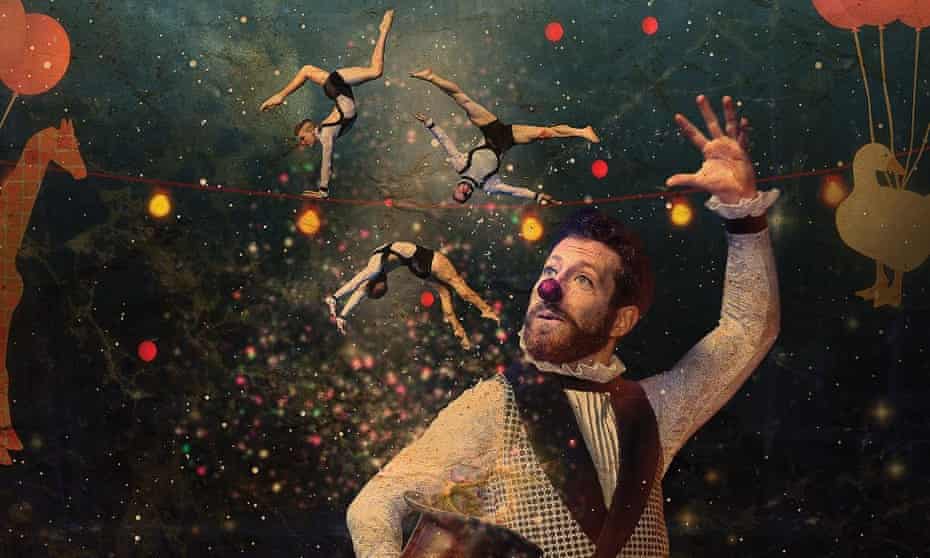
Elsewhere, there is circus aplenty.
New venue The House of Oz (at Kings Hall, which has a lovely garden set up as ‘the outback’ with colourful decorations and comfy cushions) plays host to the second Circa show at this Edinburgh Fringe – their production for children, Carnival of the Animals. Here we have a very different sort of animal to the Cirque Alfonse variety. Our team of acrobats, sporting vintage vaudevillian costumes and red noses, give us a gentle run through the animal kingdom. Using simple props like silks, different sized boxes and trunks, balloons and hula hoops – and with projected animations of cityscapes, savannahs, and underwater scenes providing the scenery – we meet and enjoy swift-swimming shoals of fish, playful penguins, trumpeting elephants, jumping frogs, and delicately floating butterflies. The circus skills are what we would expect from Circa: top notch, that is. No playing down to the children: they get the top-level tumbling and balancing and the triple towers. But all done with gentle ease, at a pace suitable for very little ones, with more than enough to interest the parents, and never any patronising of the kids or playing over their heads to the adults. It is so, so good to see children’s work of this quality.
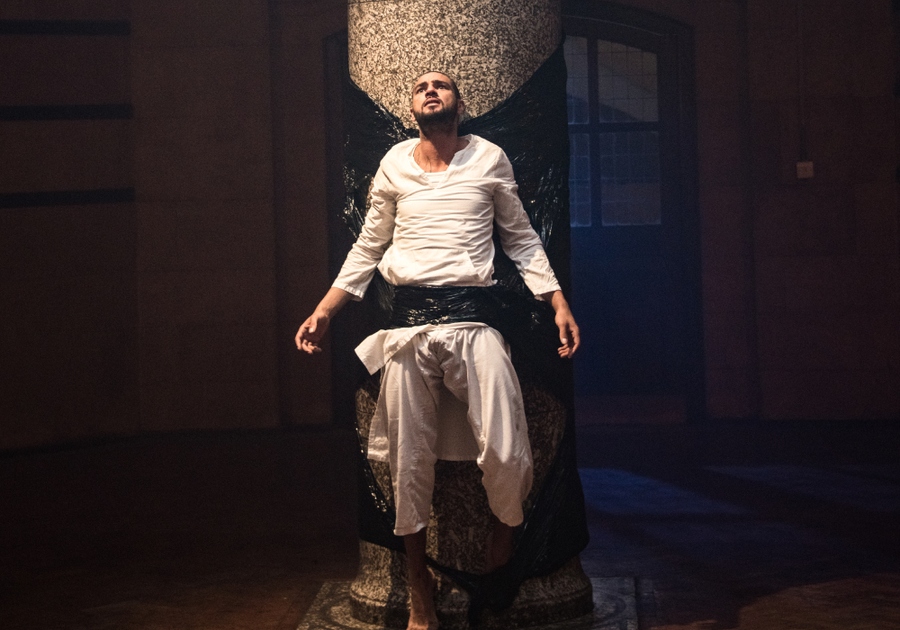
Over at Summerhall, two very different shows using circus skills in the service of experimental physical storytelling. Performed on two Chinese poles – plus a falling-apart sofa, some bottles, and rather a lot of sticky plastic – queer circus show The Chosen Haram deals with themes around sexuality, faith, addiction and connection. Lead artist/performer Sadiq Ali was born and raised in Edinburgh – and so at the show’s conclusion shares his delight with being on home territory, at the Edinburgh Fringe, and part of the Made in Scotland showcase. The Chosen Haram tells the story of two gay men and their chance meeting through a dating app. We get a breathtaking display of Chinese pole skills, some pretty sound physical acting, and a dash of high-energy disco dancing as the story moves from solo portraits of each man, their first sexual encounter (brought to us with tenderness and humour), further meetings, experiments with S&M, and outings to clubs. The show is full of strong scenes, and is performed with great skill and sensibility, but it feels like it needs a little more work on the structure. I really enjoy the show, and we have a fantastic introduction and set up, and some very strong scenes, but I feel set adrift a little after an ending which seems to suddenly just happen out of the blue.
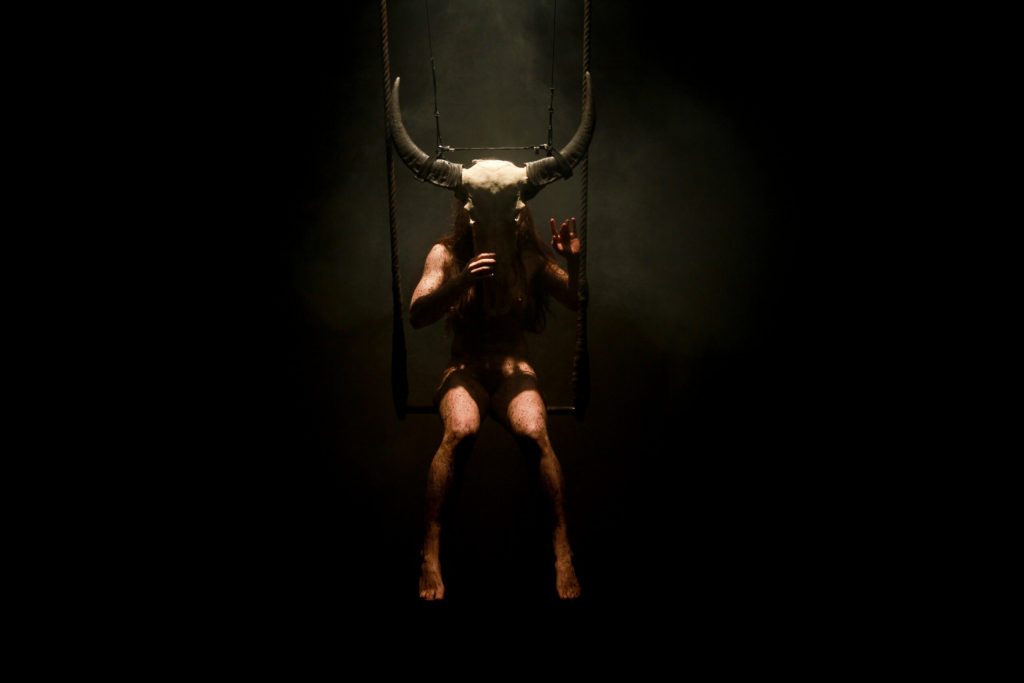
Dreams of the Small Gods is also at Summerhall, in the small and intimate Demonstration Room (The Chosen Haram plays in the main hall). This mesmerising solo is devised and performed by Zinnia Oberski and directed by Ellie Dubois. The performance tells the story of the awakening of the Wild Woman and her meeting with a horned creature from the otherworld. We first meet the Woman naked and upside down on a trapeze, her hair hanging down. As she slowly writhes and turns, her body is exposed but her face is always obscured by her hair. This is the Wild Woman in her primitive, animal-like state. This first section lasts around 15 minutes and involves minimal but effective movement, to a soundscape of gentle rustlings and whistlings. It may well be the slowest and quietest 15 minutes I’ve ever experienced in a show at the Edinburgh Fringe – and that is no bad thing. There’s a change in mood as the Woman tosses her hair back and sits on the trapeze, gently rocking and observing us calmly – then jumping down onto the earthy floor, and taking obvious pleasure in rolling in the dirt. Another change as a new element comes into the space – a fabulous (in both senses of the word) horned mask descends from on high, looking out at us eerily through the mist. A totem. A fetish. A Pagan god. Does she take on the mask, or does the mask absorb her, to make her the horned creature? Whatever way round we view it, the physical action is carefully choreographed, and the visual images created are stunning. A total gem of a show – so very different to most circus work, so meditative, so clear and confident in its dramaturgy and execution.
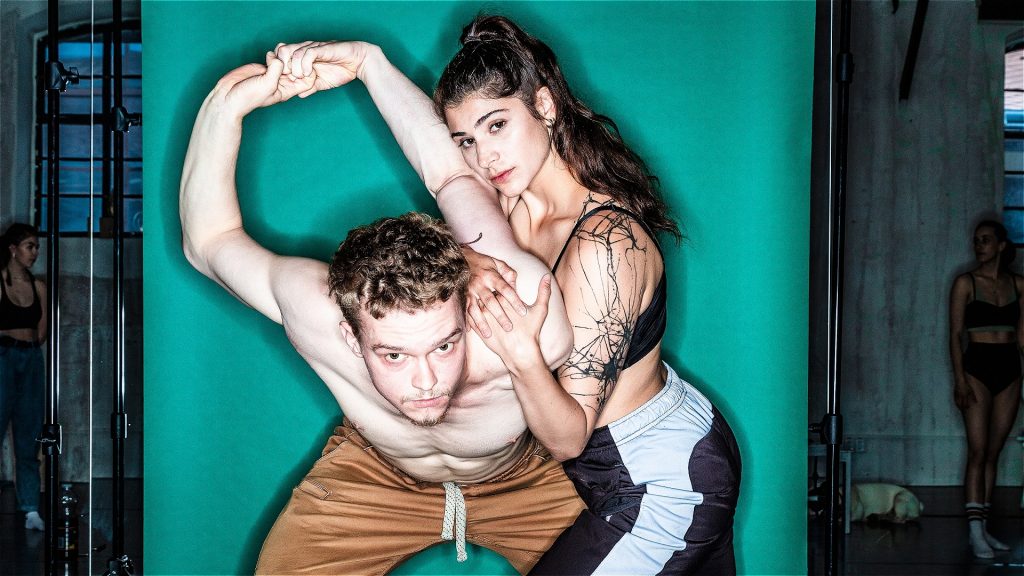
Over at the vast McEwan Hall, a very different show, one of two at this year’s Fringe from renowned Czech company Cirk La Putyka Whist the company’s established artists perform Runners at Zoo Southside, the company’s ‘young bloods’ can be found at this much more imposing space.
Boom! is a collaboration between Cirk La Putyka and Kyiv Municipal Academy of Variety and Circus Art. A few days after the outbreak of war in Ukraine, young circus students from Kyiv came to Cirk La Putyka in Prague. Together, these 16 or so Gen Z circus artists have made a show about freedom, friendship and borders. It’s all a bit messy, but that’s OK. It’s an everything-but-the-kitchen-sink show. There’s a raid-the-dressing-up-box approach to costume with baggy neon hoodies and trainers and sports bras and national costume from both countries and flowery maxi-dresses and fuchsia tutus and big bubble-heads all in the mix. There’s plenty of high-energy dance, including a nice take on Beyonce’s ‘Single Ladies’. There are words too: in at least three languages, using the now-familiar on-mic confessional motif first brought to us by 7 Doigts in Traces, as childhood memories are shared and hopes and fears and dreams are expressed. In one of the many poignant moments, we learn that both countries have a tradition of offering bread and salt to strangers – leading to an onstage breaking and sharing of the bread.
As for the physical action: there’s lots of lovely duets including a very good aerial straps routine, paired with a breakdancing boy at floor level; a clever combo of Cyr wheel and hula hoop; and a classic boy-girl acrobalance/hand-to-hand duet. We get a cabaret-style Lyra/hoop act in high heels, and some good strong Chinese pole. And there’s a juggling act that ends in a snowball fight, reminding us that these young performers are not so far away from childhood. This all accompanied by an onstage musician playing a mix of digital sounds and live guitar and keyboards. A bright and breezy show full of teenage energy and – despite the dire circumstances that brought them together – joy and lust for life.
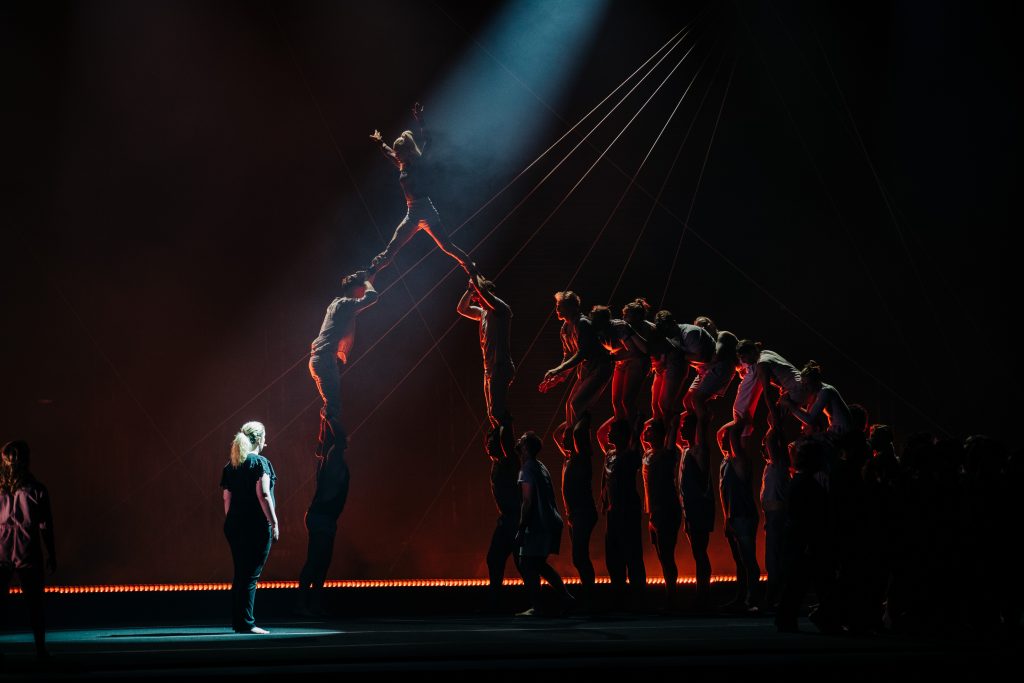
An even bigger ensemble of acrobats can be found at the Edinburgh International Festival at Gravity and Other Myths’ The Pulse. To say first of all: how odd it feels to see this company on at the EIF – they seem such stalwarts of the Fringe! But during that Covid pandemic, they got themselves some proper funding and knuckled down to make an ambitious large-scale show – without knowing when, if ever, they would be performing it. The gamble – led by company director Darcy Grant, together with designer Geoff Cobham and composer Ekrem Eli Phoenix – paid off, and here they are at the Edinburgh Playhouse: 30 of them, teamed with the same number of singers from the National Youth Choir of Scotland. This same enormous team also appeared, with extra dancers and musicians, at the EIF opening event, Macro, held at the massive BT Murrayfield stadium. But as the circus content of both events is essentially the same, I’ll focus on The Pulse.
Mathematics rules here! Sequences, sets and patterns are a key element. Whilst the singers chant ‘one two, one two three, one two three four…’ the acrobats assemble in groupings of two or three or four. In another motif running through the piece, we see human bodies as architecture: skylines of silhouetted bodies, towers that rise and fall. And my goodness, it’s very exciting to see four-high human towers! There is plenty of humour and pizazz – a comic take on ‘Mary Had a Little Lamb’ sees the ensemble ‘playing’ each other by jumping on prone bodies, eliciting a scale of howls and groans. But there are also many gentle moments. There’s a poignant ‘meeting the other face on’ scene that uses the classic physical theatre hero/chorus technique well, as a solo acrobat performs to and around the choir, then a solo singer performs to a wall of acrobats. There a few scenes that don’t quite work – a long drawn out house-lights-on race through the audience to pull out ropes into a spider web seems like too much effort for the outcome; and there’s one scene that might have worked better if placed earlier – a switch to electronic music with pulsing red light traversing the stage feels out of place so close to the end as it shifts the mood oddly. But these quibbles aside, this is a brave and bold step up for Gravity and Other Myths, and as I saw it on my last evening in the Burgh, a fitting end to my 2022 Edinburgh Festivals experience.
Featured image (top): Gravity and Other Myths: The Pulse at Edinburgh International Festival. Photo Andrew Perry.
For more information and bookings for all Edinburgh Fringe shows, see www.edfringe.com
For Gravity and Other Myths: Pulse at the Edinburgh International Festival, see www.eif.co.uk

